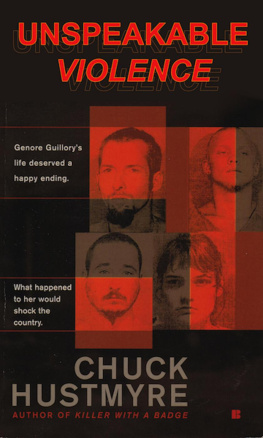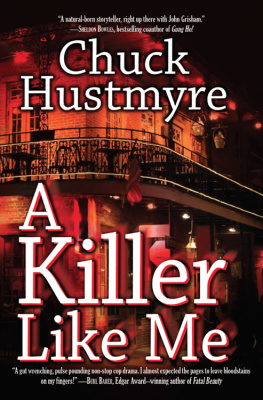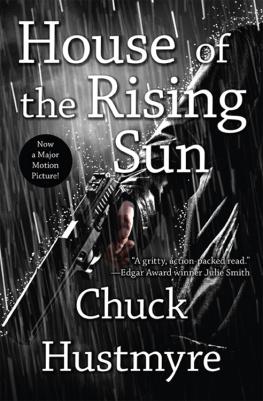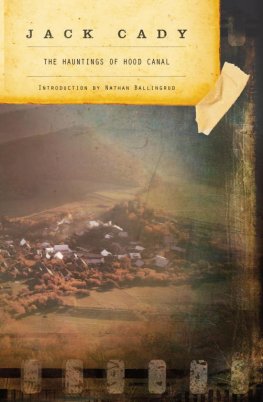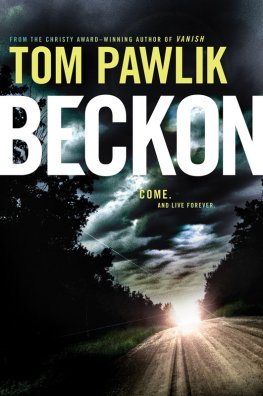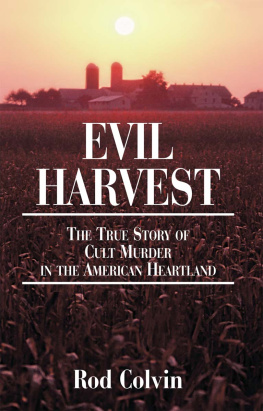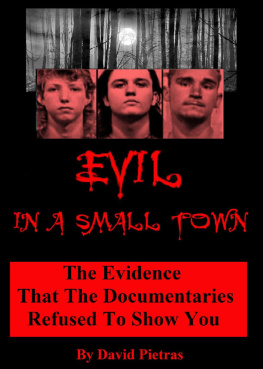UNSPEAKABLE VIOLENCE
Chuck Hustmyre
Copyright 2007 and 2018 by Charles Hustmyre
Published by Crime Ink and Draft2Digital
All rights reserved.
No part of this book may be reproduced or transmitted in any form or by any means, electronic or mechanical, including photocopying, recording, or by any information storage and retrieval system, without permission in writing from the author.
Originally published as An Act of Kindness by
Penguin Group (USA), Inc.
New York
To Genore, rest in peace.
Also by Chuck Hustmyre
Nonfiction
Killer with a Badge
Fiction
House of the Rising Sun
The Axman of New Orleans
Bloodland
The Second Shooter
A Killer Like Me
Films
House of the Rising Sun
End of a Gun
Disturbing the Peace
C LINTON, LOUISIANA , Monday, June 26, 2000, 10:25 a.m.
The smell got stronger as Deputy Ronald Johnson pushed deeper into the house. It washed over him and turned his stomach. It choked him. Johnson knew what it was. He had smelled it once before, on a suicide call. It was a smell you never forgot. It was the smell of decaying human flesh. It was the smell of death.
Johnson willed himself to breathe more shallowly. With his pistol in one hand and his flashlight in the other, he crept across the kitchen.
"Sheriff's Department," he called out. "Is anyone home?"
A sudden noise came from upstairs. Fast thumping, like someone running. Johnson squeezed the grip of his service pistol and scanned the open stairwell. The sound got closer. Something moved at the top of the stairs. Johnson aimed his flashlight and his gun. A big black and white dog, a dalmatian, rushed down the stairs. Johnson tensed, his finger on the trigger. Outside, a vicious chow had lunged at Johnson on his way into the house. He'd only gotten past it because the chow had been tied up. Now this dog was charging right at him.
But instead of attacking, the dalmatian brushed past him with barely a glance. It, too, was scared.
Johnson was shaken. He sucked in the foul air to steady his nerves. Something was definitely wrong in this house. He could feel it.
The portable police radio on Johnson's gun belt crackled to life. The tinny voice of the Sheriff's Department dispatcher called to him. "Dispatch to E-F 38, can you read me?"
Johnson tugged the radio from his belt. He keyed the microphone and tried to respond, but the signal wasn't strong enough. The dispatcher couldn't hear him.
"E-F 38?" she called again. "Can you hear me? Is everything all right?"
From Johnson's perspective, things were definitely not all right. He replaced his radio on his gun belt. Just past the kitchen was a short hallway and an open door that led to another part of the house. Johnson inched into the hall.
In the tomb-like silence of the house, the chatter on the police radio was a welcomed distraction. A couple of other patrol deputies told the dispatcher they would head toward the house on Oakwood Lane and check on Deputy Johnson.
In the hallway, Johnson peeked around the edge of the open door. He saw a bedroom. A four-poster, queen-sized bed stood against the far wall, the bed covers piled together on top of the mattress. A small table had been knocked over and sat upended in the middle of the floor. From inside the room the smell came at Johnson hard. He felt sick, like he was going to throw up. He fought past it and stepped through the door.
Inside the bedroom, the walls were splashed with blood. A window that looked out onto the yard had a bullet hole through it. Another bullet had punched through the wall above the bed, and a third had pierced the headboard. The body of woman lay on the floor beside the bed. She was mostly naked, bloated, disfigured. Blood was everywhere.
Johnson refused to believe what he was seeing. The body looked like a mannequin. It's not real, Johnson thought. He took another step closer. The woman lay on her back near the far corner of the room, her swollen body covered only by a green nightshirt that had been pushed up to her breasts. Her head was tilted to the left, and her tangle of black hair only partially masked a face that had been beaten nearly flat.
She wasn't a mannequin. She was real. And she was as dead as dead can get.
Deputy Johnson bolted from the house.
Outside, the sun was shinning. It was a beautiful early summer morning.
In the driveway, Johnson braced a hand against the fender of his Jeep Cherokee. He bent over and retched. From the police radio mounted inside the Jeep, Johnson heard the nearly frantic voice of the dispatcher calling for him. "E-F 38, E-F 38, I need you to respond."
Johnson opened the driver-side door and grabbed the microphone, but he was so overcome with emotion that he couldn't speak.
Several minutes passed before Johnson pulled himself together enough to find his voice.
When he did, he keyed the microphone and called for the dispatcher. Still short of breath, Johnson gasped out, "I have a signal 29 (dead body) out here. I need you to notify the detectives and E-F one."
E ast Feliciana Parish Sheriff's Detectives Don McKey and Drew Thompson arrived at the house on Oakwood Lane at 10:50 a.m.
The home where Deputy Ronald Johnson had discovered the mutilated body was a two-story Acadian style, with dark siding and a big front porch. It sat at the end of a long driveway on several acres of semi-wooded property. Beside the house stood an attached carport stacked with fifty-pound sacks of dog food and baled hay. Twenty yards behind the house was a cement slab surrounded by a chain-link fence. It was a kennel for twenty-five, maybe thirty dogs, all of them barking. Other than the sheriff's cars, two Toyotas were parked near the house. One was a small pickup truck, the other a Camry.
The address was 11856 Oakwood Lane. It was about five miles northeast of the town of Clinton and less than ten miles south of the Mississippi state line. Oakwood Lane was a dead end gravel road no more than a mile long. It ran off of Rist Road, a dirt road to nowhere that had been cut between two backwoods state highways. Only a few residences dotted the landscape along either side of Oakwood Lane. The dark side of the moon was more out of the way, but just barely.
The dispatcher told McKey that a State Police forensic team and the deputy coroner were on the way. The two detectives started their initial crime scene survey. They moved from outside to inside, from farther out to closer in.
The purpose of the survey was to get an overview of the crime scene, to look at the big picture prior to getting into the detailed, inch-by-inch examination and before beginning the process of collecting evidence.
Next page
